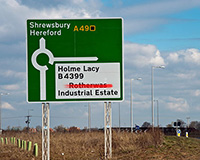Rural people think differently about land. They like to own it and control it; land means status and security. They don’t particularly like to rent it.
So when Hereford’s premier industrial estate was granted enterprise zone status, its guiding spirits did not turn to a developer, sign a joint venture, and get some attention-seeking speculative development under way. No, what they did was sell off plots.
The 170-acre enterprise zone at Rotherwas industrial estate – now slightly bafflingly renamed Skylon Park (see right) – has clocked up 5.5 acres of land sales in three transactions. These are expected to produce around 48,000 sq ft of new, predominantly industrial, floorspace. Meanwhile, Herefordshire council, with European Union funding, is behind a £1.8m project to provide an 11,000 sq ft enterprise hub of 10 small units.
The park is meant to provide 6,500 jobs. So far, 120 have come to the site.
Slow progress in the three years since the zone was designated? Skylon managing director Mark Pearce says not. “Compare what we’ve done with what happened in the 10 previous years, when not a lot got built,” he says.
Pearce says seven more plots are under offer, a total of around 34 acres. All the occupiers and interested parties are local businesses, predominantly manufacturing firms. Serviced land in the zone sells for £180,000-£200,000 an acre. About 80% of the land in the zone is owned by Herefordshire council; the rest belongs to the Goodwin Trust.
Pearce gives the impression that a developer-partner is the last thing he wants. “We’re selling land direct to occupiers, and we think a joint venture with a developer would mean slower progress,” he says.
“A national developer would inevitably make priority choices on locations to develop, and that might slow Hereford down. We wouldn’t turn away a developer if they showed commitment, but levels of freehold interest in the zone are healthy. If that interest dries up, we might have to look at other ways to proceed.”
According to Jeremy Phillipson, director of research at Newcastle University’s Centre for Rural Economy, Hereford’s approach points to a problem with enterprise zones in rural areas.
“Most EZs have been urban and policy has been very urban-centred in outlook. EZs work best when you have bigger businesses looking for premises, and that doesn’t translate well to rural areas, where the business structure is often smaller,” he says.
The problems of tenure – and the rural preference for freehold – also play a part. Says Phillipson: “The idea of forming business clusters, which is behind EZs, might work better in rural areas handled in a different way. Pilot projects to create rural growth networks (RGN) are trying to pick up on the cluster idea in the more dispersed business environment of rural areas. There could be important lessons here for local enterprise partnerships and for the government.
“The RGNs that have been set up so far have different ownership structures. Some are more private sector led, others more public sector, and we have a mix of tenures. We are still some way from understanding how those things affect their success.”
Hereford’s EZ still has a long way to go. It has infrastructure issues to confront (see panel) and has so far missed out on big relocations. East European aerospace manufacturers had been tipped to take a 24-acre slice of the site, but concluded in 2013 that their UK markets did not justify a base in England.
According to Pearce, the enterprise zone incentives – due to expire in 2018 – are helping to concentrate the minds of local business people, and having the effect of accelerating their decision-making about premises.
“If a local businesses is expanding, the 2018 deadline can help bring a decision forward. The incentives on offer are not a reason in themselves for moving, but they are a reason for getting on with it,” he says.
That kind of prudent rural approach could keep Skylon busy for the next three years.
History
Bosses at Hereford’s enterprise zone could have chosen a name that announced the 170-acre industrial area to outsiders. Instead they opted to name it after the Skylon monument, largely forgotten outside Hereford, a tall cigar-shaped object built in the city for the 1951 Festival of Britain.
Rural growth networks
Unlike enterprise zones, rural growth networks are not focused on property. A shared rented office and a pool of supportive people are at the core of the new enterprise hubs, envisaged as promoters of local business clusters. They are places to share experience.
Newcastle’s Centre for Rural Economy has been studying a network of 20 hubs in the North East and says they amount to “honey pots and hives” promoting activity in rural areas.
The Long Road
Plans for a link road between Skylon Park and the A465 and improved links to the A49 appeared to come unstuck this spring, when the Highways Agency declared it wouldn’t support the plan.
The route, which would help improve links to the enterprise zone, has become entangled with controversial plans for a Hereford bypass. It would cost around £27m, sources suggest.
Herefordshire council is undaunted, and is promoting the plan itself. A council spokeswoman said: “We do not have a firm idea of funding for the road as yet.”
A link road improving connections between Skylon and the main road network was completed in 2008.
Skylon Park’s Mark Pearce says: “We will happily have any infrastructure investment going. We need better collective infrastructure in Herefordshire.”











